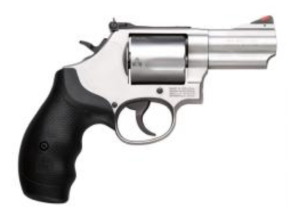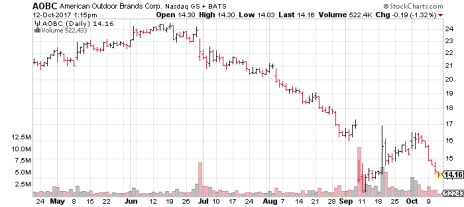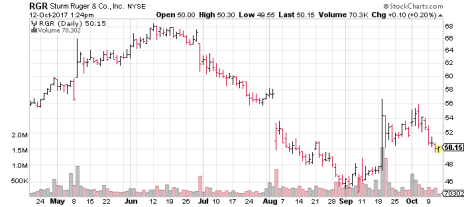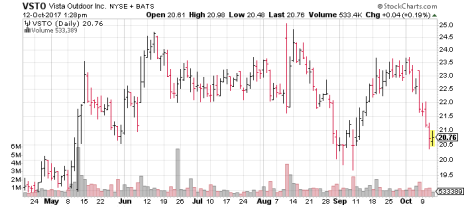After every mass shooting, the topic of gun control gets headlines. And after every mass shooting, the prospect of increased gun control sparks the buying of more guns. As a result, gun stocks tend to get a boost. More on those in a minute.
Barack Obama was good for the firearms industry, as there was always the threat of increased gun control, but the election of Donald Trump has been a disaster for sales. Gun owners know that their guns are safe—for now.
But the mass shooting in Las Vegas once again sparked heavy buying in the three main publicly traded companies in the U.S. that make and sell guns, so today I’m going to take a closer look at these three gun stocks.
[text_ad]
Gun Stock #1: American Outdoor Brands (AOBC)
Headquartered in Springfield, Massachusetts, home of the Springfield rifle, this company is far better known as Smith & Wesson, which was founded way back in 1852.
But the company changed its name to American Outdoor Brands in January 2017, and now, in addition to Smith and Wesson firearms and ammunition, the company also has divisions that make and sell prisoner restraints, hunting and shooting accessories, laser sights, knives and survival equipment.
Smith & Wesson Model 69 Combat Magnum – $849
AOB’s brands include M&P, Thompson/Center Arms, Crimson Trace, Caldwell Shooting Supplies, Gemtech Silencers, Wheeler Engineering, Tipton Gun Cleaning Supplies, Frankford Arsenal Reloading Tools, Lockdown Vault Accessories, Hooyman Premium Tree Saws, BOG POD, Golden Rod Moisture Control, Schrade, Old Timer, Uncle Henry, UST, Imperial and Bubba Blade.
Most recently, handguns accounted for 62% of the company’s revenues, long guns for 20% and other outdoor products the remaining 18%.
In fiscal year 2017, ended April 30, the company reported record revenues of $903 million, and record earnings of $2.58 per share. But in the first quarter of fiscal 2018, revenues were only $129 million, down 38% from the year before, while earnings were just two cents per share, down 97% form the year before.
The problem is that a year ago, gun sales were huge as enthusiasts (fearing the election of Hillary Clinton) expected increased gun control legislation, but since Trump was elected, sales have slowed dramatically. Also, according to management, successful fourth-quarter promotions stole sales from the first quarter.
Whatever the reason, analysts have been lowering their projections. The consensus now is that earnings will shrink to $1.14 in fiscal 2018, a decline of 56%, before rebounding to $1.69 in 2019.
As for the stock’s chart, it peaked at 31 in August 2016, and has been working its way lower since, losing more than 50% of its value by early September when the terrible first-quarter results were released.
Since then, buyers have driven the stock from below 13 to above 16 last week, but the uptrend is not long enough yet to conclude that the main trend has changed.
Still, bargain-hunters may be interested. The stock’s current P/E is just 8, while its P/E on the upcoming weak year is 17.
Gun Stock #2: Sturm Ruger (RGR)
Located in Southport, Connecticut, and founded in 1949, Ruger makes and sells pistols, revolvers, rifles and shotguns, primarily for the commercial sporting market, though some product goes go to law enforcement. Accessories account for just 3% of revenues.
Ruger Model 8661—9MM Luger - $579
In the second quarter, ended July 1, revenues were $132 million, down 21% from the year before, while earnings were $0.57 per share, down 53% from the year before.
The problem, according to management, was not only strong sales in the previous year, thanks to the political climate, but also aggressive discounting by competitors.
As with AOBC, analysts have been reducing their estimates. Currently, the consensus is for earnings to shrink 22% this year to $3.60 per share and then rebound 17% in 2018 to $4.22 per share—which would still be below the record $4.59 in 2016.
As for the stock’s chart, it peaked at 86 back at the start of 2014, a 78 in March 2016, and at 69 in mid-June of this year—after which it fell to a low of 46.
Then, just like AOBC, it rallied, driven by bargain-hunters. But as with AOBC, I can’t say the new uptrend is long enough to be real.
Note: RGR pays a dividend of 1.7%, but that’s small comfort when your stock is falling.
Gun Stock #3: Vista Outdoor (VSTO)
Headquartered in Farmington, Utah (in part because the state offered tax credits), Vista is a young company, though it can trace its parentage back through Alliant Techsystems (a defense contractor) to Honeywell, which traces its roots to 1888.
Unlike the first two companies, Vista’s is more diversified; it’s primarily an outdoor products company. While its firearms brands include Federal Premium, Savage Arms, CCI, Speer and Stevens (and account for slightly more than 50% of revenues), its non-firearms brands include Bushnell, Camelbak, Camp Chef, Primos, Bollé, Bell, Giro, Serengeti, Jimmy Styks, Cébé, RCBS, Hoppé’s, Uncle Mike’s, Gold Tip, Weaver, Blackburn, KRASH!, Copilot, Raskullz and Tasco.
Savage MSR 15 Patrol – $868
Among the products made are binoculars, trail cameras, archery accessories, protective eyewear, fashion and sports eyewear, helmets, hydration systems and stand up paddleboards.
Vista Outdoor has been growing steadily through acquisition. Fiscal 2017, ended March 31, saw revenues grow 12% to $2.54 billion, while earnings fell 24% to $1.90 per share.
The first quarter of 2017, however (ended July 2), brought the same troubles experienced by the first two companies; revenues were down 10% from the prior year to $569 million (removing the effect of the latest acquisition, they were down 13%), while earnings were down 50% to $0.24 per share.
As for the stock, Vista started trading in March 2015 (after being spun off from Alliant), and for the first year, trended slowly higher, peaking at 54 in March 2016. But since then, the trend has been strongly down.
VSTO bottomed at 18 in April of this year and has made a little progress since then, but overall the stock has done no better than the broad market.
Now, if the drumbeat for increased gun control legislation persists, the recently renewed appetite for firearms may continue, and growth-oriented investors might see attractive trends.
But my money says they won’t and the reason is that the idea is too obvious. Everyone has already been exposed to that line of reasoning.
Furthermore, none of these three gun stocks fit any of the proven Cabot investing strategies (value or growth) and none of them have been recommended by Cabot analysts—and it’s not wise to go outside of our successful systems just because a recent news event highlights a potential investment.
Instead, your odds of success are much better if you follow proven investment systems, and invest in stocks that aren’t obvious to everyone.
For example, back in 1998, I recommended Amazon (AMZN), when it was a money-losing but fast-growing bookseller that most people expected would crash and burn, and that became a 1,245% winner.
And in 2011, I recommended Tesla (TSLA), when it was a money-losing developer of electric cars that most people expected to fail. That investment is now up 1,121%—and still growing.
And just two weeks ago, I recommended a money-losing developer of a simple, unobtrusive test for colon cancer that’s both convenient and accurate. It’s not a name most investors are aware of yet, but if I’m right, it could be another big winner!
Readers of my Cabot Stock of the Week are already on board, but it’s not too late. You can get all the details on this high-potential little-known stock when you join my readers.
And you can start by clicking here.
But don’t delay. Act today, while the bull market is alive and well!
[author_ad]











